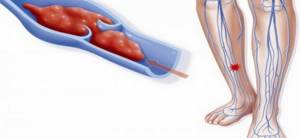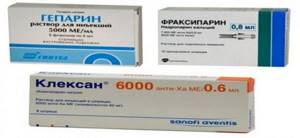What is RFMK, thrombinemia
Dear Luna 78!
Soluble fibrin monomer complexes (SFMCs) are markers of thrombinemia during intravascular coagulation. The RFMK test allows you to quantify the level of soluble fibrin in plasma, that is, the level of thrombinemia. An increase in the number of RFMK is observed during thrombosis, DIC syndrome, and in late pregnancy in accordance with the increase in fibrinogen content. RFMK is a marker of intravascular coagulation. Thus, its increase indicates the development of DIC syndrome.
Detailed description of the study
The balance of the action of the coagulation and anticoagulation systems of blood in the body (hemostasis) is maintained through many reactions and the complex interaction of proteins with each other. Against the background of severe illnesses, injuries and burns, surgical interventions and some other pathological conditions, disseminated internal coagulation syndrome (DIC syndrome) may develop.
In disseminated intravascular coagulation syndrome, hemostasis is impaired, and against the background of an increased tendency to bleeding, blood clots—thrombi—form in the vessels.
Normally, fibrin protein is an intermediate product formed when fibrinogen is destroyed by another protein, thrombin. These substances are one of the key blood clotting factors.
In intravascular coagulation disorders, thrombin levels are low and the amount of fibrin is insufficient to form a clot. Instead, it binds to fibrinogen or its breakdown products, resulting in the formation of soluble fibrin-monomer complexes (SFMCs). Thus, RFMKs are microthrombi found in the blood.
If the concentration of RFMC increases, this indicates an increased tendency of the body to form blood clots.
The formation of blood clots usually requires a combination of unfavorable factors, such as hereditary predisposition, decreased physical activity, and insufficient fluid intake.
One of the conditions in which there is a tendency to blood clots is pregnancy. The formation of microthrombi in a woman’s body can impair blood flow in the placenta and lead to pregnancy loss.
Determination of the RFMK indicator can be carried out to identify disseminated intravascular coagulation syndrome, the causes of thrombosis, their risk during pregnancy, as well as during heparin treatment. The test is used for indirect diagnosis of placental blood flow disorders; together with coagulogram indicators, it helps to identify impaired hemostasis.
Changes in hemostasis in pregnant women
During pregnancy, the hemostatic system plays an important role in maintaining the normal functioning of the placenta and the condition of the unborn child. During this period of a woman’s life, physiological changes occur in the hemostasis system, caused by the appearance of an additional “third” circle of blood circulation—the uteroplacental one. Changes in the volume of circulating blood and hormonal levels, as well as preparation for natural blood loss during childbirth also affect the “pregnant restructuring” of the blood. However, significant changes in the hemostatic system of a pregnant woman are not only undesirable, but also dangerous.
Why is the level of soluble fibrin monomer complexes in the blood determined?
What is RFMC?
Soluble fibrin monomer complexes or abbreviated as RFMC. Normally, under the influence of thrombin, fibrin is formed from its monomers. This process is understood as the formation of a clot. At the same time, in healthy people, the process opposite to the formation of a clot begins - its splitting or fibrinolysis. The balance of these two processes keeps our blood in a liquid state.
In case of a shift in the balance of the coagulation and anticoagulation systems of the blood, pathological conditions develop, such as thrombosis and thrombophilia.
In pathology accompanied by an excess of thrombin, fibrin monomers accumulate, which form complexes. Determination of the level of RFMK is carried out when performing a coagulogram.
Studying the level of these monomeric complexes is not a routine analysis; most often they are determined as additional ones.
Norm
Normally, the content of these soluble complexes should not exceed 40 mg/l or 4 mg per 100 ml of blood. Some clinical diagnostic laboratories may give an answer in the form of a positive or negative result. In such cases, a negative result is considered normal.
However, standards in different laboratories may differ, so it is worth relying on the reference values used by test system manufacturers.
Also, in the case of determining indicators over time, you should choose the same laboratory. Since different medical organizations may use different test systems that differ in characteristics.
At the moment when the blood coagulation system “pulls the blanket over itself,” an increase in the content of fibrin monomers in the blood occurs.
In what cases is RFMC analysis prescribed?
RFMC plays an important role in the diagnosis of hemostasis disorders that maintain blood in a liquid state, especially in pregnant women. But more on that a little later.
In addition, the level of fibrin monomer complexes is determined:
- immediately before surgery;
- when diagnosing a condition such as DIC syndrome (disseminated intravascular coagulation syndrome);
- if a pathology of the hemostatic system is suspected, for example, venous thrombosis;
- when monitoring the effectiveness of anticoagulant therapy.

Treatment of DIC syndrome, coagulation disorders, hypercoagulation
If there is a history of problematic pregnancy or miscarriage, then aspirin and/or dipyridamole (chimes), heparin may be prescribed. It is necessary to focus more on your own well-being and the nature of the pregnancy. Considering that normal levels of fibronogen in pregnant women are 2.6 - 5.6 g/l, RFMC up to 5.1 mg/100 ml, you need to make an appropriate correction. It is better to contact the doctor who is managing your pregnancy and consult with him.
Sarklinik wishes you and your future baby good health.
Related posts:
The child has tics, blinking, nose twitching, jumping, vocalisms, treatment in Russia, Moscow, Saratov
Enuresis what to do, how to treat
Entered and immediately came, treatment in Russia, Saratov
Health care, rehabilitation, occupational therapy, physiotherapy, reflexology
Child's diet, dairy allergy
Comments ()
How to properly prepare for the test?
To perform an analysis for RFMK, venous blood is usually taken. In order for the analysis to be most accurate, a number of simple rules should be followed.
- Blood should be donated on an empty stomach. It is advisable not to eat or drink in the morning before blood collection.
- It is not recommended to smoke several hours before the blood collection procedure.
- It is also important to abandon folk remedies that thin the blood.
- You should consult your doctor regarding the medications you are taking. Some of them can significantly affect the results.
- It is recommended to refrain from physical and emotional stress.
Thus, if you follow these simple rules, the result will be more reliable.
What are the dangers of elevated RFMC levels during pregnancy?
We do not intend to intimidate the expectant mother, but we want to remind you that the significantly increased result is not caused by harmless reasons. It can be:
- Thrombophilia, which is usually hereditary in nature and manifests itself especially aggressively during pregnancy. This pathology, creating a high risk of clot formation, interferes with the normal course of the pregnancy process (miscarriages). The task of the gynecologist in this case is to carefully consider a plan of therapeutic measures that create conditions for bearing the fetus for up to 7 months (35 - 36 weeks), when the baby, although weak, is quite viable;
- A history of thrombosis during pregnancy may reappear, so this condition is considered an indication for more frequent testing of soluble fibrin-monomer complexes;
- Disseminated intravascular coagulation syndrome, which can be caused by a variety of causes (infections, shock, trauma, autoimmune diseases, neoplasms, late toxicosis, purulent inflammation, cardiovascular and other chronic pathologies), during childbirth can become an uncontrollable process with a very sad end. . The risk of developing disseminated intravascular coagulation syndrome makes it necessary to monitor the level of RFMC very often, which the expectant mother must understand and strictly follow the doctor’s prescriptions in order to save the life of herself and her child.

To avoid severe complications during childbirth (in particular, disseminated intravascular coagulation syndrome), unscheduled administration of additional coagulogram parameters (RFMC, D-dimer, etc.) is indicated in the presence of:
- Severe diseases of the liver, kidneys, lungs;
- Autoimmune diseases;
- Cardiovascular pathology;
- Neoplasms;
- Varicose veins of the lower extremities;
- Diseases of the endocrine system, for example, diabetes;
- Purulent inflammation;
- Gestozov;
- Increased RFMC before pregnancy;
- Bad habits (smoking – primarily, including passive smoking);
- Pregnancy that occurs after artificial insemination using IVF;
- Multiple pregnancy.
Any deviations from the normal values of hemostasiogram parameters should be carefully rechecked and studied. If the RFMC is elevated for several weeks, the gynecologist, depending on the degree of increase in the indicator, prescribes treatment, which often takes place in a hospital setting (this, first of all, applies to cases when the concentration jumps sharply and exceeds the norm several times). A pregnant woman, for her part, must be aware of her share of responsibility in order to prevent terrible complications and fully experience the happiness of motherhood. Unfortunately, there are undisciplined pregnant women who ignore doctor’s advice, do not come for tests on time, refuse hospitalization, lead an unhealthy lifestyle, and then indiscriminately make complaints to all doctors in a row.
Features of the analysis
One of the methods for determining RFMK is the orthophenanthroline test.
The essence of this method is to determine the time during which fibrin flakes are formed when phenanthroline is added to blood plasma. The stopwatch starts immediately when the reagent is added. Accounting occurs within 150 seconds.
If during this time no flakes are formed, then the test is considered negative, that is, the concentration of complexes of fibrin monomers is within normal limits.
If visible flakes form earlier, then the test is considered positive, and the quantitative determination of RFMK occurs using special tables depending on the time during which the fibrin monomer grains were formed.
For example, below is such a table.
| Flake formation time | RFMK concentration |
| 10 Seconds | 21 mg/100 ml |
| 20 seconds | 11 mg/100 ml |
| 27 seconds | 8 mg/100 ml |
| 40 seconds | 6 mg/100 ml |
It is worth noting that the concentration of RFMC in the blood is directly dependent on the time of appearance of the flakes. That is, the faster the flakes appear in the test tube, the greater the concentration of these complexes in the patient’s blood.
Decoding the results
It is worth recalling that deciphering the analysis results should be entrusted to a specialist. The patient should not do this alone.
RFMK below normal
Typically, high levels of RFMC are of diagnostic value. And there is no lower limit of reference values as such. That is, the absence of fibrin-monomer complexes in the blood indicates that the coagulation and anticoagulation systems of the blood are in balance, maintaining the blood in a state necessary for life.
Increased RFMK values
An excessive amount of complexes formed by soluble fibrin monomers indicates activation of blood coagulation processes. This indicator is important in diagnosis:
- disseminated intravascular coagulation syndrome;
- pulmonary embolism;
- deep vein thrombosis;
- used to monitor the effectiveness of anticoagulant therapy.
RFMK in pregnant women
Pregnancy is a big burden on the mother's body. Therefore, it is extremely important to monitor the progress of this process. If any pathology develops, doctors will help the expectant mother carry and give birth to a child.
Thus, determining the level of RFMC in a pregnant woman is extremely important.
Normal values for the level of soluble fibrin monomer complexes are higher in pregnant women. However, depending on the gestational age, the boundaries of the norm change.
As mentioned earlier, the doctor, not the patient, should interpret the test results. But the expectant mother should know the dangers of a high level of RFMK.
- High RFMC numbers indicate possible thrombophilia. This is a condition where the body tends to form excessive clots. As pregnancy progresses, this can lead to miscarriage.
- Again, the development of DIC syndrome.
- Thrombosis – the formation of blood clots that interfere with normal blood flow.
For what pathologies in pregnant women should the level of RFMC be monitored?
In the presence of pathology of the liver, kidneys, or cardiovascular diseases, the level of soluble fibrin monomer complexes should be determined. You should also monitor the hemostasis system in a pregnant woman if there have been venous disorders or bad habits before.
In case of multiple pregnancy or pregnancy as a result of in vitro fertilization, the hemostatic system should be carefully monitored, including determining the concentration of RFMC.
If a woman wants to carry and give birth to a healthy child, she needs to listen to the doctor’s recommendations and do what he asks.
Who and how corrects changes in the level of RFMK?

The level of fibrin monomer complexes in the blood can be adjusted. Only a doctor can do this!
Most often this occurs due to the prescription of anticoagulants, which keep the blood in a more fluid state than it was before. However, if the dosage is incorrectly selected, the opposite process can occur - thinning the blood to such an extent that it will be difficult for it to clot. Then this will lead to numerous bleedings.









